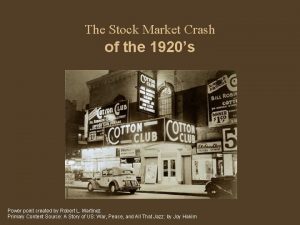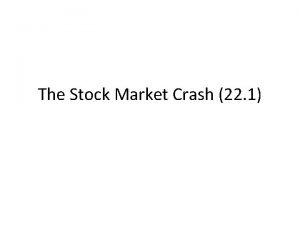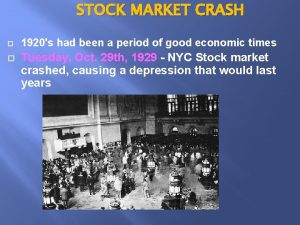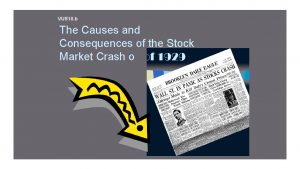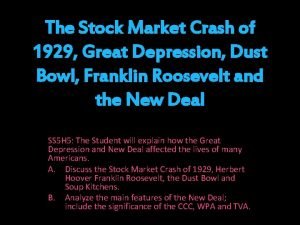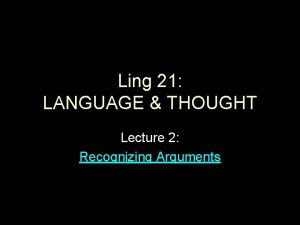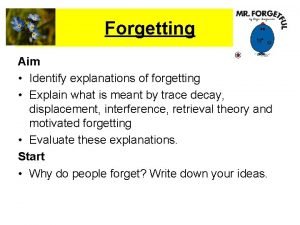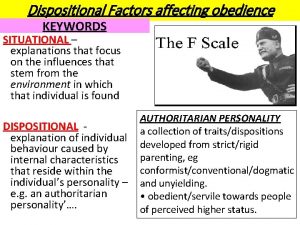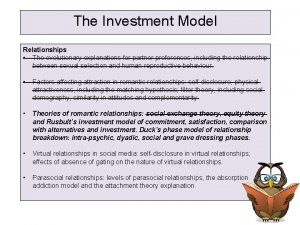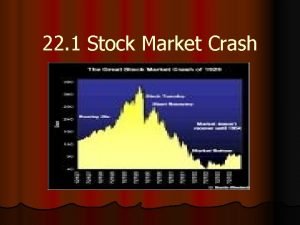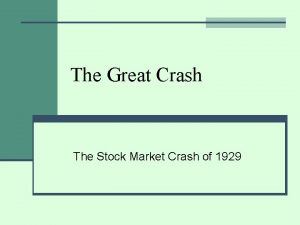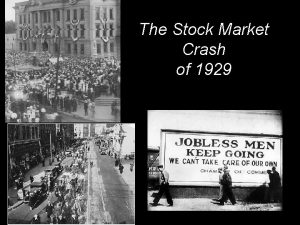2008 MACROFINANCE CRASH Explanations Questions Stock Crashes in



























- Slides: 27

2008 MACROFINANCE CRASH Explanations & Questions

Stock Crashes in 20 th and 21 rst Centuries

U. S. Stock Crashes and Macroeconomic Events

Can Financial Events Cause Macroeconomic Problems? � “Payments crises” (liquidity crises) � Debtors (first level) stop payments � Lenders (first level) income drop, reduce payments on short term loans � Short-term (money market) lenders income drop, reduce payments … � Consumption/Investment effects � Wealth (balance sheet) effects: firms, households reduce consumption/investment as wealth decreases � Debt/Income ratios: solvent firms, household reduce consumption/investment to bring debt to income ratios down

Framework for Thinking about Debt and Macro Outcomes � Infinite Horizon Economy Budget Constraint: PV Income + PV Debt � “NPG” Condition: Over the long run income funds consumption (not debt) � � = Debt Service + PV Consumption Entire economy faces a budget constraint just as households or government Sustainable Long Run Relationship: Income – Consumption – Debt Service >= 0 � Income Growth > Interest Rate on Debt �

Example Calculations on Sustainable Debt/Income Ratios

Aggregate U. S. Debt and Debt/GDP Levels

Mortgage Debt only Part of the Story: Commercial Lending a Bigger Part

Debt Growth in 2000 s High Relative to Prior (growing) Trend

Case Study of U. S. Debt $11 Billion City Center Project Las Vegas – MGM Mirage Bank Loan/Bond Funded

1920 s Equity “Bubble & 2000 s Debt “Bubble”: Same Story, Different Financial Instruments � Whether Debt-instrument (bond, loan) funded or Equity (stock) funded, ultimate value is net revenue stream from project (Modigliani-Miller Theorem) � High Debt or Equity values imply high expected future net revenue � Consider 2 Scenarios for City Center (at $10 B nominal value) Case 1: $9 B in Shareholder Equity with $1 B in bank debt; � Case 2: $1 B in Shareholder Equity with $9 B in bank debt: � Actual PV of future net revenue of project = $5 T � With project bankruptcy: � Case 1: Bank claims bankruptcy value = $1 B � � Case 2: Bank claims bankruptcy value = $1 B � Original shareholders lose $9 B New shares issued worth $4 B Loss in balance sheets = $5 B Shareholders lose $1 B Bank loses $8 B in value up front; issues new stock and regains $4 B Loss in balance sheets = $5 B In both cases, assets on balance sheets over-valued by $5 T; purchases made with this “leverage”

1920 s: Stock Valuations Indicating Very High Net Revenues to Make Sustainable

Common Explanations � Long Run Problems: Mortgage markets overvalued � Fed & other gov’t guarantees (moral hazard) pushing mortgage markets � Fed supplied too much money to markets in early 2000 sseparating “systemic” v. non-systemic problems � Poor pricing models separating “systemic” v. nonsystemic problems pushing too much money into mortgage markets � Short Run Sparks � Uncertainty about Fed reaction � Lack of Fed reaction (2007 -08) � Marked-to-market accounting for mortgages

Evaluating “Policy Uncertainty” Thesis: Financial Stress Appearing Long Before Sept 08

Why So Much Attention on Mortgage Debt? � See mortgage debt as leading indicator, not as only cause � Fire analogy: room with fire in it first does not tell you about the fuel and match � Mortgage debt securitized-tradeable; � Quickly � reflecting change in valuations Commercial bank loans non-tradeable; � Held at bank estimated values for longer

Causes of Debt/GDP Expansion: Cheap Credit 9 8 7 6 5 1990 -99 2003 -07: 7 4 3 2 1 0 Prime AAA BBB Fed Funds Com. Paper

Cheap Credit: Fed Responsible?

Cheap Credit: Public Sector Supply

Cheap Credit: Private Sector Supply

Cheap Credit: Increasing Leverage

Cheap Credit: Inflow of Foreign Capital

Role of Foreign Capital?

Cheap Credit: Innovations? � Securitization, e. g. CDOs � Pooling � mortgage (other debt) risk (CDOs, SPVs) Credit Insurance � Transferring Risk (CDS) � Cochrane: can shuffle risk around, but not change total amount � Evaluation: � CDOs, CDS actually relatively small versus size of overall debt growth

Marked-to-Market Accounting? � � How big of an effect is possible from MTM pricing of banks? See SEC Dec. 2008 Study www. sec. gov/news/studies/2008/marktomarket 123008. pdf � 31% of bank assets MTM 22% of these impact income statement Part of this amount in Treasuries � Differences in MTM and “amortized cost” � If 20% difference, then 4. 4% impact on income � Currently, using “amortized cost” method Citi assets increase by apx. $3 B (out of $1. 2 T) Bo. A assets increase by apx. $9 B (out of $1. 4 T)

Solutions? � Cochrane: � Specify � systemic risk for Fed, limiting TBTF Stiglitz, … � Limit financial innovation � More stringent oversight � Poole, Bullard, BG, … � Raise equity standards � Limit financial firm size Charge insurance fee based on size Explicit size limitations

Higher Equity Standards the answer? Modigliani-Miller Theorem: Capital Structure Irrelevance � No difference of debt v. equity (ownership shares) financing of projects if � Asset prices move with statistical independence; � Asset prices are information based without systematic errors; � Taxes treatment of both sources is the same � Bankruptcy treatment of both is the same � No asymmetry of knowledge among borrowers, lenders, shareholders � Implies capital structure matters to the degree that these conditions matter

Debt-GDP Ratios 20 s/30 s v. 2000 s
 2008 2008
2008 2008 Most work zone crashes
Most work zone crashes Most work zone crashes dmv
Most work zone crashes dmv Speeding crashes
Speeding crashes Stock market crash in 1929
Stock market crash in 1929 Stock market crash 1929 political cartoon
Stock market crash 1929 political cartoon Stock market crash 1942
Stock market crash 1942 Stock market in 1920
Stock market in 1920 Black friday stock market crash
Black friday stock market crash Fun facts about the stock market crash of 1929
Fun facts about the stock market crash of 1929 Vus.10b when was the stock market crash?
Vus.10b when was the stock market crash? Chicago bulls and bears stock market
Chicago bulls and bears stock market New deal tennessee valley authority
New deal tennessee valley authority Mr betts stock market crash
Mr betts stock market crash Stock market crash
Stock market crash Examples of common sense and sociological explanations
Examples of common sense and sociological explanations Arguments and explanations
Arguments and explanations Underwood and postman 1960
Underwood and postman 1960 Monotropy meaning bowlby
Monotropy meaning bowlby Dispositional factors of obedience
Dispositional factors of obedience Cognitive explanations of schizophrenia
Cognitive explanations of schizophrenia Dust bowl migration map
Dust bowl migration map Russian revolution cartoon
Russian revolution cartoon Epq spec
Epq spec Neural explanations of offending behaviour
Neural explanations of offending behaviour Gender dysphoria biological explanations
Gender dysphoria biological explanations Rusbult's investment theory
Rusbult's investment theory Diathesis stress model
Diathesis stress model







